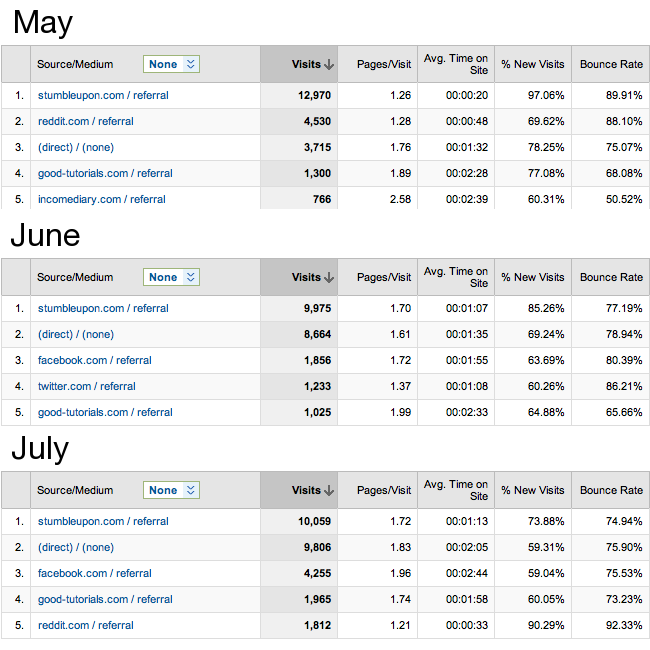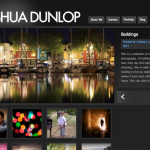
Introduction
Since starting my website 3 months ago I’ve gone from effectively talking to nobody, to receiving 140,291 pageviews from 83,930 visits, from 62,162 different people, looking at 53 different posts. In this post, I’m going to walk you through, month by month, all the notable moments of my website – ExpertPhotography.com. Here is a brief summary of all the stats from the past 3 months; 22nd of April to the 21st of July. 
Traffic
Getting traffic is job number 1 for any new website, and it’s not something that I’ve had too much trouble with, which I wrote about in this blog post about the 7 different ways I drive traffic to my website. What I’m most interested in is pages per visit, bounce rate, average time on site and percentage of new visits – they all talk about what your visitors are doing when they get onto your site. Getting someone to visit your site, it’s really not the problem if your content is good, it’s getting them to stay on the website for longer (and hopefully clicking on adds) that really matters.
If you look at the 3 month comparison chart below, you’ll notice that not only is my traffic improving, but so is everything else. You may look at the percentage of new visits and think that it going down is actually a bad thing, but I look at it the other way; it shows that i’m building a following while improving my traffic at the same time. Average time on the site is important for me as a writer because it tells me how long people are reading what i’m writing, which is a good way of gauging the reception of what i’m writing. As my following has improved, so has the time on the site, which I put down to the repeat visitors who have found my site, coming back and reading what I have to say.
For those that don’t know, the bounce rate is the percentage of visitors that only look at 1 page when they enter the site, and this is directly related the pages/visit stats listed below. As you can see, over the past 3 months, my bounce rate has improved and I put this down to the use of a very helpful plugin called SEO Smart Links which will automatically link keywords to their respective posts. If you know what your keywords are, then it makes them much easier to include them in your posts, which will send people all over your site. Here‘s an example of a post, which on first glance looks like just a guide to using your flash, when really it was written to include as many keywords as I could so that I could get people reading more of my material, all over my site. Adding this feature means that only 44.66% of visitors to that page left without clicking on another link.
The pages with the worst exit rates are typically posts that I know people have linked to, or posts that have done well on sites like Reddit. These are my most popular posts and for me are top lists and tutorials on the basics of photography, which have an exit rate of about 75-80%. This isn’t a particularly good rate, but the purpose of these posts was to get people to read the articles, not to look all over my site – any extra time they spend on my site is a bonus.
Traffic Sources
Knowing where people are coming from to get to your site is very important in helping you to target your content to more visitors. Google Analytics don’t just allow you to see where visitors have come from, they also tell you how long they stay on your site, the percentage of new visits and bounce rates, which is very useful in gauging the value of each visitor. Have a look at my traffic source info for the past 3 months below.

StumbleUpon is responsible for roughly 40% of all the traffic that I’ve had on my site, and back in May, the average time on the site was only 20 seconds, nothing to really celebrate. I should have paid more attention at the time to the traffic from StumbleUpon because I didn’t realise it at the time, but they were going to become a much more valuable visitor. When you start to get recognised by sites like these, it means that what you’re writing is carrying some weight and people are beginning to become interested in what you have to say. It’s one thing to promote yourself, but it’s another thing for someone to find you.
If you have a look at the timeline below, you’ll see the traffic that has come from StumbleUpon marked by a blue line, and the site’s overall traffic, which is marked by a thin grey line. There is obvious correlation between the site’s traffic and SU, but only when it comes to day-to-day visitors, not when I receive my two biggest peaks in traffic. If you can target your writing towards stuff that sites in your niche, or material which SU like, then they will help to build a strong daily following for you. The two largest peaks in traffic have come from people tweeting and sharing one of my posts and a very large company sharing one of my tutorials, respectively.
 StumbleUpon is great for traffic, but if you really want to start making a living from blogging, you need to get Google on your side. I personally use it countless times a day, and rarely even scroll down when I get my results, meaning that you need to need to start ranking as high as you can, as soon as you can.
StumbleUpon is great for traffic, but if you really want to start making a living from blogging, you need to get Google on your side. I personally use it countless times a day, and rarely even scroll down when I get my results, meaning that you need to need to start ranking as high as you can, as soon as you can.
For Google to start recognising you as a valuable source, other people have to recognise you too, so the best way to do that is to write content that other people will talk about and link to. In my recent post ‘6 Types Of Posts That Drive Traffic‘, I like top-lists as the best way of doing this, because they’re usually easy to read, and everyone seems to have an opinion on what you’ve written. Opinions are great because when people disagree with each other, it’s sparks more debate and people share your link more.
The first 2 spikes in traffic in April and June were both times that I wrote top lists, the third spike at the beginning of July was when someone at Adobe Lightroom posted my link to all of their followers on Facebook and Twitter. Boosts in traffic are great and your following will grow from them, but the most important difference that I’ve found this makes, is the amount of search engine traffic you start to receive. Sites like Google see that people are bouncing your link about the internet and that gives you more credibility with them, and they start to rank you higher in their searches.
To demonstrate what these boosts in traffic have done to my site, have a look at the graph I put together below, where you can clearly see that spikes in traffic have made a tremendous difference to the amount of people who can find my site, where they once may not have known about it. The difference in search engine traffic remains constant even after the initial rush of visitors arrive and it’s died down to a day to day traffic.

Traffic Locations
Knowing the location of my visitors hasn’t really made a huge difference to how I write, but it has made a small difference in the words that I use. America has their own spellings of certain words and different slang that appeals to them more, which I try to use as much as I can, but the real reason for knowing which country your readers come from the most is so that you can make your links more relevant. For this post, I was recommending gear for my readers to buy, and my links were going through Amazon.com, where I would earn a commission. Had I set those links to the UK site, the likelihood of me making any money becomes a lot smaller. 
Money
Few people could afford to do this if it weren’t for the fact that they were either getting paid, or could see themselves getting paid somewhere in the near future. We’ve experimented with our website and the positioning size of different ads to make us the most money possible. We’ve also recently put up a BuySellAd in the hopes that someone will want to advertise there and we can guarantee a certain amount of money each month for the website, without having to worry about traffic or AdSense.
If you look at the insights for my Google AdSense account below, you’ll see that we’ve started to make more money each month from Google, but unfortunately we’ve not been making much money recently, even though there’s a noticable difference in traffic to the month before. This tells us that either we’ve got a different type of reader now, or we need to change the types of ads we’re putting on the site. It could be both, but either way, we need to start appealing to more people and addressing the problem if we want to start seeing some more money.
Most Popular Content
If you take a look at my list below, you’ll see the types of posts that are really popular are my top lists, the tutorials I’ve written on the most basic part of my niche, and articles that I consider easy to read such as ‘10 Reasons Your Photos Suck‘. It’s no secret the effect that writing top lists will have on your website and 3/4 of my ‘Top 20’ lists are in my top 10 most viewed pages, and not only that, the average time on those pages is actually reasonably high. That’s another thing that all the top 10 pages have in common, they all have very good average time on site, which tells me that people aren’t just visiting the page, they’re spending time reading the content too, and this is particularly important if your website relies its income on people clicking on adverts.
When I first started writing tutorials, I started with the basics, and I never really considered that they would be the most popular posts, in fact, I thought that by the time I had built a following, those tutorials would be lost. The traffic that started coming to these posts picked up over time when readers started sharing them, and in the case of number 4 on the list, Adobe Lightroom shared it. I would rather have fewer visitors who spend longer on the site, and that’s what happens when your content is directly targeted to people in your niche. People who look at these sorts of tutorials differ from your other readers because they’re actively looking for the essential information that they need, not just wasting time scanning over easy to read tutorials – that’s why writing these sorts of tutorials are so important.
The third type of tutorial on this what I would label as easy-to-read because, they’re written in list format with clearly written points as headings, and images to demonstrate the point. There’s the option to read more information, which will help the reader to learn more, but in my personal experience, I rarely read more than I have to. The reason for people staying on these sorts of pages are mostly because I include lots of photos, which interest the reader and helps to demonstrate the point that I’m making. 
A Note To Finish
When I first started writing my blog, it was a small page attached to my photographic portfolio and there was basically nobody reading it – that was back in the beginning of April and I never really envisioned that I would be dealing with the sort of traffic I am today after only 3 months. If you’re just starting out, then I would encourage you to read the other articles I’ve written for this website here and learn from what I’ve already learnt. The important thing to remember is that if you write often enough, your content is good enough, and you market it well, it’s only a matter of time before your site is a success. Good luck.












